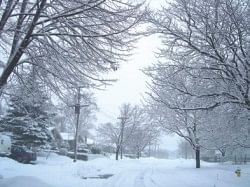Death by Landscape

"Whose woods these are I think I know.
His house is in the village though;
He will not see me stopping here
To watch his woods fill up with snow"
My backyard has transformed overnight into a wintry wonderland. As I peer through my dinning room French windows, rubbing my nose slightly along the frosted pane, misting it with my breath, I can see the woods beyond, the trees dusted with the silvery tinsel lights of frost. Here and there, I spot little footprints in the snow, a rabbit, perhaps or a little fox, venturing out for any kind nourishment that it may find. I miss my little friends, the garbage scavengers - the black-eyed raccoons with which I have sworn enmity during the warmer months but as the days begin to cool, and so do our differences.
Winter and snow enthrall me even without the promise of spring in the distance. It's a time of inner thoughts, a time of reflection and finally a time when words come alive on paper in a manner they do not in spring. I try to keep a full agenda in the winter with a good round of friends to entertain and warm homes to go to. I put my children in for skating, piano, swimming lessons and enlist myself for the mind and body healing that Yoga brings about. We have lots of hot chocolate and cuddle up with books to read to pass away the winter evenings. The children tackle books such as "The Tiger Came to Dinner" and the latest "Gears of War" game journals, while I ponder away with the Russian giants such as "The Brothers Karamazov" and "Anna Karenina". I see the snow, but I look beyond, through the eyes of others, through the written word, though music and through my little Russian paintings with St Basil's Cathedral and Russian pristine landscapes that hang on the wall.
I miss a small set of Russian miniature paintings that I had on my dinning room wall a long time ago, but misplaced in the scuffle of changing countries, homes and lives. My mother gave this set to me when I came to Canada, a lifetime away. The oil paintings were exquisite one portrayed a bare tree in the winter-its branches spiked with hard frost. The manner that the painting was drawn appeared to be a grim reminder by the Russian artist that winter was harsh and that one could die by exposure to the landscape in Russia. Or for that matter here in Canada. On the other hand, the other oil painting was that of a country cottage set in a spring setting with a profusion of vivid colours symbolizing life itself. "Place them side by side on the wall", my mother said to me. Paintings were a source of comfort to her, I knew not why then.
They were showing re-runs of Boris Pasternak's Dr.Zhivago on TV on Christmas day and as I watched this movie with its freezing landscapes and the eternal struggle of human beings for the possession of another's mind and soul and the utter futility of it all, it occurred to me, by looking at the credits, that most of the movie had actually been filmed in Saskatchewan, Canada. The Russian and Canadian landscapes and temperatures are similar, and in that era it must have been easier to film here rather than in the Cold War climate of the U.S.S.R.
There sat my favourite protagonist, Dr.Zhivago, trying to write poetry, but only succeeding when the temperatures plunged and he was in a frosty wonderland, away from revolution and responsibility. He hopes for the promise of spring and it eventually returns to the Russian landscape but his time is spent on this earth.
Margaret Atwood, a leading Canadian novelist, feels that death in Canadian fiction is almost always a negative part of the loser/victim syndrome and Nature-as-monster theme. The reality for Canadian writers and their protagonists is that they pit themselves against the harsh landscapes that they live in. A short story that she wrote, called "Death By Landscape" in which two young girls go camping and one girl simply vanishes into the landscape. The camp counselors think that the protagonist Lois is actually partly responsible for her friend's disappearance and Lois grows up with a sense of guilt. As an adult, she surrounds her self with paintings of Canadian landscapes drawn by the famous Group of Seven* painters. Her paintings give her a sense of comfort as she tells herself-"Every one has to be somewhere, and this is where Lucy is. She is in this apartment in the holes that open inwards on the wall, not like windows but like doors. She is here. She is entirely alive". In Lois's mind, Lucy did not die-she is there lost somewhere in the landscape.
Though I have lost my Russian miniatures oils, they still simmer in the mind's eye in the wintertime, on my wall. Who hides behind my landscapes, who plays hide-and-seek behind the birch trees that glisten in the sunlight? Is it my little brother? A lost friend? Peeking from the mists of childhood? Whoever they are, they bring me fleeting joy as I turn from one painting to another and know not the difference between winter and spring.
The woods are lovely, dark and deep
But I have promises to keep,
And miles to go before I sleep
And miles to go before I sleep.

 For all latest news, follow The Daily Star's Google News channel.
For all latest news, follow The Daily Star's Google News channel. 



Comments